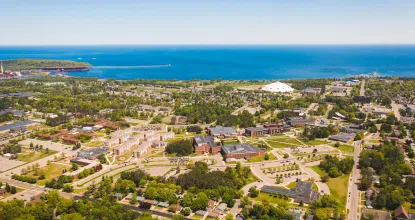
Northern Museum of Zoology
Established in 1974 by J. Kirwin Werner and Lewis Peters, the Northern Museum of Zoology is an important resource for NMU students and faculty, as well as researchers at other institutions. The collections have particular strengths in the fauna of the Great Lakes Region. They are maintained by faculty curators and student collection managers, and they support teaching and research in the Department and beyond. Specimen data are served globally via biodiversity data portals VertNet and GBIF.
NMU class instructors who wish to request specimens for use in classes should fill out and submit this form.
Collections
Vertebrate collections: All major lineages of vertebrate organisms are represented in the vertebrate collections, including fluid-preserved fishes, amphibians and reptiles, bird skins and eggs, and mammal skins, skulls, skeletons, and frozen tissues. Faculty curators include Alec Lindsay (birds; >300 specimens), Jill Leonard (fishes), and Kurt Galbreath (mammals; >4000 specimens).
Invertebrate collections: These are the largest and most diverse of the Department’s collections. Cumulatively numbering in the tens of thousands of specimens, the invertebrate collections include aquatic and terrestrial insects (including Luther West’s personal entomology collection), Lake Superior wave-zone invertebrates, freshwater sponges, gastropods, leeches, and parasites. The parasite collection has particular strengths in fleas and tapeworms of small mammals in Michigan and the western United States. Faculty curators include Ben Tumolo (free-living invertebrates) and Kurt Galbreath (parasites).
Specimen database: Specimen data from the NMU collections are in the process of being digitized and entered into the Arctos museum collection management system. Digitized data are freely accessible to educators and researchers and can be searched here. Currently, data for mammals, birds, and parasites are available through the database. Our goal is to continue to digitize the remaining collections as resources permit.
Loan policy: We encourage the use of our data and specimens for non-destructive research and teaching purposes. All loan requests must be directed to the curator who is responsible for the relevant collection, and should be in the form of a signed cover letter on institutional letterhead outlining the request. The letter should include a brief summary of the research, including the qualifications of the requester, description of research objectives, timeline for the study, justification for the request (including availability of other material that will be used in the study), relevant data collection methods to be used, and a list of the specific specimens that are being requested. Additional conditions of loans beyond those described here may be deemed appropriate depending on the nature of the loan.
Researchers who are interested in using specimens are encouraged to visit in person, as we are a small museum with minimal resources and our capacity to pack and ship loans is limited. For loans that we do ship, all shipping costs must be covered by the recipient of the loan, and therefore a UPS account number to which the shipping costs will be charged must be provided. We are currently unable to ship loans via other carriers (e.g., FedEx).
Northern Michigan University retains ownership of all loaned specimens. Recipients of loans are not permitted to provide either the specimens or their derivatives (e.g., DNA extracts) to a third party without written consent from the appropriate curator. All specimens and derivatives (including DNA extractions from tissues) must be returned to NMU upon completion of the project for which the loan request was made. All publications, GenBank submissions, or other products of research that uses NMU specimens must acknowledge the use of those specimens and cite them by their NMU catalog number.
For general queries regarding NMU's zoological collections, contact Kurt Galbreath.
Huron Mountain Club Museum
In 2020, NMU and the leadership of the Huron Mountain Club Museum (HMCM) worked together to share the HMCM's specimen data with the scientific community via the Arctos database. This rich resource of >3000 specimens representing vertebrates, invertebrates, and plants offers an important record of Upper Peninsula biodiversity that spans the last century.
Huron Mountain Club Museum specimens are not available for loan. Qualified researchers may request opportunities to inspect specimens on site. Queries regarding the HMCM collections can be directed to Kurt Galbreath.
